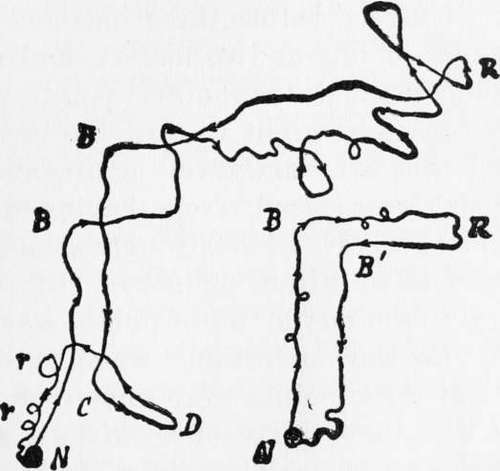(3) Turner's "Circling"
Description
This section is from the book "The Psychic Life Of Insects", by E. L. Bouvier. Also available from Amazon: The Psychic Life of Insects.
(3) Turner's "Circling"
During the second part of their journey, that of their return, the workers march in perfect order toward the nest, in a straight line or one parallel to the line of coming out (Figure 14), without the circuits necessitated by the search for food, but, arrived near the nest, the insect changes its attitude; it hesitates, searches, describes-circles or sinuous arcs of a circle which finally lead it to the orifice. This is what Cornetz called Turner's circling, using the name of the learned American who has best studied this phenomenon.
Although well oriented during its return, it is rare that the explorer goes- straight to the orifice of the nest. The first orientation cannot be perfect, and also the road of return is not superimposed on that of going. It is more or less parallel, so that it will be to one side as it approaches the nest. But arriving in this region, the insect recognizes familiar objects and familiar odors ; it can perceive the odor and perhaps the noise of the nest. Thus its memory comes into play and chooses the proper guides to lead it to the nest, which it finds by its circlings (Figure 14, C, D, r, r).
Sometimes one of the guiding points seems to be sufficient, and then the insect makes a sharp turn to march directly to the orifice. This is the way with Cataglyphis. Cornetz followed one of these running ants during its return journey. Its march was rather sinuous, but at a point situated some meters from the nest it started straight toward it. It turned before the orifice and stopped at a distance of one or two meters, and resumed the sinuous method to another point, where it suddenly turned straight toward the nest. Cornetz tried this over and over again, and found that the ant recognized, from having doubtless visited them already, a certain number of guiding points fixed in its visual memory. According to Cornetz, a single one of these points was enough to give it "the pure direction" which led it to the orifice. But these points were numerous. There were not less than thirty of them in a space of eighteen meters where Cornetz made his experiments. Thirty, without counting those which he did not discover! That is a good many "pure directions " to be kept in the memory of an ant ! Is it not more logical to believe that the insect simultaneously sees, several points of near-by guides, a small local topography, and that it utilizes these to establish the direction of its nest! The Cataglyphis ants have a distinct sight. According to Cornetz, they can distinguish the form of the smallest objects at five or six centimeters, and many guiding points are at a lesser distance in the plane which the author studied in the course of his interesting experiment.

Fig. 14.-The going and returning of an exploring ant. At the right, a scheme of going and returning in the opposite direction. At the left, the real path of an exploring Messor which, leaving its nest N, made from B to R a side exploration, coming straight to B', where she made an angle equal to B, but, having taken this angle a little too soon, wandered from C, D through r, r, and finally found her nest again. The distance from C to D was about 1 meter. (After Cornetz).
This circling is always carried on when the ant seeks its nest, even when it is far away. Having gathered some Cataglyphis at the moment they were starting out, Cornetz placed them several meters away. Completely upset, they described larger and larger circles,-which permitted them, without doubt, to find guiding points and to gain their nest.
Continue to:
